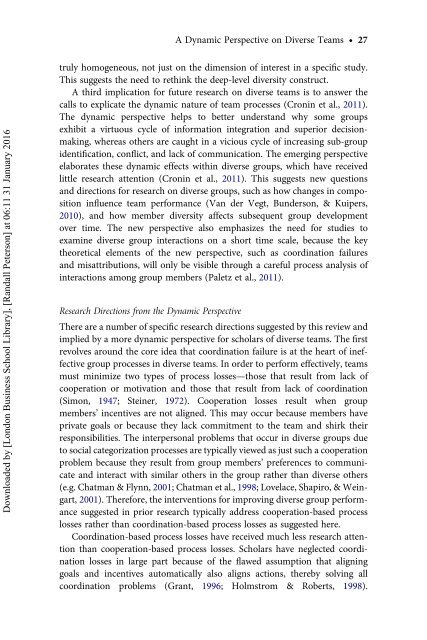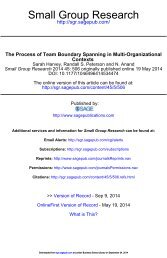A Dynamic Perspective on Diverse Teams: Moving From The Dual Process Model to A Dynamic Coordination-Based Model of Diverse Team Performance - Kannan Srikanth, Sarah Harvey & Randall Peterson
The existing literature on diverse teams suggests that diversity is both helpful to teams in making more information available and encouraging creativity and damaging to teams in reducing cohesion and information sharing. Thus the extant literature suggests that diversity within teams is a double-edged sword that leads to both positive and negative effects simultaneously.
The existing literature on diverse teams suggests that diversity is both helpful to teams in making more information available and encouraging creativity and
damaging to teams in reducing cohesion and information sharing. Thus the
extant literature suggests that diversity within teams is a double-edged sword
that leads to both positive and negative effects simultaneously.
You also want an ePaper? Increase the reach of your titles
YUMPU automatically turns print PDFs into web optimized ePapers that Google loves.
A <str<strong>on</strong>g>Dynamic</str<strong>on</strong>g> <str<strong>on</strong>g>Perspective</str<strong>on</strong>g> <strong>on</strong> <strong>Diverse</strong> <strong><strong>Team</strong>s</strong> † 27<br />
Downloaded by [L<strong>on</strong>d<strong>on</strong> Business School Library], [<strong>Randall</strong> Peters<strong>on</strong>] at 06:11 31 January 2016<br />
truly homogeneous, not just <strong>on</strong> the dimensi<strong>on</strong> <strong>of</strong> interest in a specific study.<br />
This suggests the need <strong>to</strong> rethink the deep-level diversity c<strong>on</strong>struct.<br />
A third implicati<strong>on</strong> for future research <strong>on</strong> diverse teams is <strong>to</strong> answer the<br />
calls <strong>to</strong> explicate the dynamic nature <strong>of</strong> team processes (Cr<strong>on</strong>in et al., 2011).<br />
<strong>The</strong> dynamic perspective helps <strong>to</strong> better understand why some groups<br />
exhibit a virtuous cycle <strong>of</strong> informati<strong>on</strong> integrati<strong>on</strong> and superior decisi<strong>on</strong>making,<br />
whereas others are caught in a vicious cycle <strong>of</strong> increasing sub-group<br />
identificati<strong>on</strong>, c<strong>on</strong>flict, and lack <strong>of</strong> communicati<strong>on</strong>. <strong>The</strong> emerging perspective<br />
elaborates these dynamic effects within diverse groups, which have received<br />
little research attenti<strong>on</strong> (Cr<strong>on</strong>in et al., 2011). This suggests new questi<strong>on</strong>s<br />
and directi<strong>on</strong>s for research <strong>on</strong> diverse groups, such as how changes in compositi<strong>on</strong><br />
influence team performance (Van der Vegt, Bunders<strong>on</strong>, & Kuipers,<br />
2010), and how member diversity affects subsequent group development<br />
over time. <strong>The</strong> new perspective also emphasizes the need for studies <strong>to</strong><br />
examine diverse group interacti<strong>on</strong>s <strong>on</strong> a short time scale, because the key<br />
theoretical elements <strong>of</strong> the new perspective, such as coordinati<strong>on</strong> failures<br />
and misattributi<strong>on</strong>s, will <strong>on</strong>ly be visible through a careful process analysis <strong>of</strong><br />
interacti<strong>on</strong>s am<strong>on</strong>g group members (Paletz et al., 2011).<br />
Research Directi<strong>on</strong>s from the <str<strong>on</strong>g>Dynamic</str<strong>on</strong>g> <str<strong>on</strong>g>Perspective</str<strong>on</strong>g><br />
<strong>The</strong>re are a number <strong>of</strong> specific research directi<strong>on</strong>s suggested by this review and<br />
implied by a more dynamic perspective for scholars <strong>of</strong> diverse teams. <strong>The</strong> first<br />
revolves around the core idea that coordinati<strong>on</strong> failure is at the heart <strong>of</strong> ineffective<br />
group processes in diverse teams. In order <strong>to</strong> perform effectively, teams<br />
must minimize two types <strong>of</strong> process losses—those that result from lack <strong>of</strong><br />
cooperati<strong>on</strong> or motivati<strong>on</strong> and those that result from lack <strong>of</strong> coordinati<strong>on</strong><br />
(Sim<strong>on</strong>, 1947; Steiner, 1972). Cooperati<strong>on</strong> losses result when group<br />
members’ incentives are not aligned. This may occur because members have<br />
private goals or because they lack commitment <strong>to</strong> the team and shirk their<br />
resp<strong>on</strong>sibilities. <strong>The</strong> interpers<strong>on</strong>al problems that occur in diverse groups due<br />
<strong>to</strong> social categorizati<strong>on</strong> processes are typically viewed as just such a cooperati<strong>on</strong><br />
problem because they result from group members’ preferences <strong>to</strong> communicate<br />
and interact with similar others in the group rather than diverse others<br />
(e.g. Chatman & Flynn, 2001; Chatman et al., 1998; Lovelace, Shapiro, & Weingart,<br />
2001). <strong>The</strong>refore, the interventi<strong>on</strong>s for improving diverse group performance<br />
suggested in prior research typically address cooperati<strong>on</strong>-based process<br />
losses rather than coordinati<strong>on</strong>-based process losses as suggested here.<br />
Coordinati<strong>on</strong>-based process losses have received much less research attenti<strong>on</strong><br />
than cooperati<strong>on</strong>-based process losses. Scholars have neglected coordinati<strong>on</strong><br />
losses in large part because <strong>of</strong> the flawed assumpti<strong>on</strong> that aligning<br />
goals and incentives au<strong>to</strong>matically also aligns acti<strong>on</strong>s, thereby solving all<br />
coordinati<strong>on</strong> problems (Grant, 1996; Holmstrom & Roberts, 1998).
















